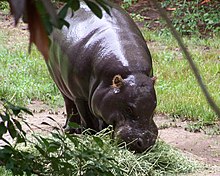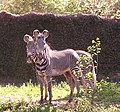Jackson Zoo
| Jackson Zoo | |
|---|---|
 | |
 | |
| 32°19′13″N 90°13′15″W / 32.3202°N 90.2207°W | |
| Date opened | 1919[1] |
| Location | Jackson, Mississippi |
| No. of animals | 776[1] |
| No. of species | 120[1] |
| Annual visitors | 170,000[1] |
| Memberships | ZAA[2] |
| Website | www |
The Jackson Zoo is located in Jackson, Mississippi. The Jackson Zoo was established in 1919 and exhibits over 200 species and nearly 380 individual animals, providing the public the opportunity to observe and study wildlife from around the world and region.[1]
The Jackson Zoo is situated within the historic 110-acre (0.45 km2) Livingston Park and welcomes approximately 112,000 visitors annually from Mississippi and surrounding states. 20,000 school children make their way to the zoo throughout the school year.[1]
Guests can also enjoy fare from the Elephant House Cafe, purchase keepsake merchandise from the Jackson Zoo Trading Company. Picnics are permitted in Livingston Park and rides are available on the Endangered Species Carousel or the train. A Splash Pad is open in the summer.
The Jackson Zoo is the second largest zoo in the state (behind the 175-acre (0.71 km2) Tupelo Buffalo Park and Zoo) and is the only zoo accredited by the Zoo and Aquarium Association (ZAA) in the state.
History of the Jackson Zoo
In 1916, the city of Jackson purchased from Samuel Livingston 79 acres (320,000 m2) of undeveloped land, then on the outskirts of town. By 1919, a group of firefighters were collecting various animals, housing them in the central fire station, what is now the Chamber of Commerce Building.
In 1921, after the collection had evolved from rabbits and squirrels to include exotics like zebras, the city decided to move them to the newly purchased land and the Livingston Park Zoo was created.[3]
In the 1930s, many new buildings were erected with help from the Works Progress Administration (WPA) during the Great Depression. The City of Jackson, like almost every other city and state, used funds from the New Deal programs to create construction jobs for its citizens in those hard times. With the public works, the City and zoo director Irl Bennett left a heritage of facilities that have served Jackson for some 80 years. Today, many of the buildings constructed by the WPA are still standing. At the time, the Castle served as Monkey Island, housing several dozen rhesus macaques and the Elephant House Café was home to a young Asian elephant. The grounds also served as a park to its visitors, with much of the zoo's land remaining open, a scenic location with a lake for visitors to enjoy during the hot summers.
In 1948, the collection was expanded thanks to the efforts of Dr. Jacob L. Reddix, President of Jackson State College. With his help, the zoo was able to purchase several rain forest specimens from the government of Liberia, including three chimpanzees, three rare mangabey monkeys, a colobus monkey, a lemur, and two pythons.
In 1962, three African American residents of Jackson sued the City of Jackson for de facto segregation of the city's recreational facilities, including the city's zoo, golf courses, pools, and parks. Even though a three judge panel concluded that the arrest of an African American "boy and girl" at Livingston Park was an "isolated publicity stunt," the court did not agree with the city's argument in favor of "voluntary segregation" and supported the racial integration of all of Jackson's recreational facilities, including Jackson Zoo.[4] Soon thereafter, instead of allowing for a seamless integration of the Jackson's recreational facilities, Mayor Thompson ordered all of the city's public pools and bathrooms closed, while also removing benches and picnic tables from public parks, including the Jackson Zoo.[5]
In the 1970s, the children's petting zoo was added, later renovated to what is now the Discovery Zoo. An animal hospital was built to perform routine checkups, for surgeries for any of the residents, and to quarantine new arrivals before they can live amongst the permanent collection. In 1975, James L. Swigert became the director. With the help of the City Council and a design group, he put together the first Master Plan.
In 1985, taking in more space from Livingston Park allowed for the development of the African Rainforest Exhibit. In 1987, Barbara Barrett Piazza was hired as director. In 1989, accreditation came from the Association of Zoos and Aquariums (now known as the AZA).
In 1995, the state government provided $4 million for improvements to the facilities. In 1998, the city agreed to a $1.5 million match. Including the African Savannah and the Mississippi Wilderness Exhibits, it would be the largest capital improvement project in the zoo's history.
In 1996, the zoo became a member of a community organization called ZAPP (Zoo Area Progressive Partnership) in an endeavor to assist with the regeneration of the neighborhoods surrounding the location.
In 2004, the Friends of the Zoo installed a new Endangered Species Carousel. Built with the site in mind, it features zebras, leopards, giraffes, and tigers to ride, instead of the traditional horses. Even an alligator bench was built, with handicapped accessibility.
In 2005, the African Savannah Exhibit opened to the public. Barbara Piazza retired as director; Beth Poff became the fifth.
In 2006, the Wilderness Mississippi area opened. Renovations were completed to exhibit two orangutans from Borneo. The zoo was named a "Southern Travel Treasure" by AAA Magazine.
In 2007, recognizing the expanded facilities, the Jackson Zoo was named the "Travel Attraction of the Year" presented by the Mississippi Tourism Association; it received the "Attraction of the Year" at the Jackson Convention & Visitors Bureau Summit Awards. Drawings began for Asia exhibit improvements, including a new tiger facility and a water garden.
Also in 2007, a groundbreaking was held for the Gertrude C. Ford Education Center in the Wilderness Mississippi area. In October that year, renovations were completed in the animal hospital, with state funding and donations from Baptist Medical Center.
In August, 2018, amid an ongoing funding crisis, the Jackson Zoological Society asked for, and received, Director Poff's resignation the same day in which the City of Jackson provided a $200,000 bailout.[6] Director Poff was asked to resign for misusing state funds to improperly cover operating costs, an event that caused the City of Jackson to begin the search to replace the Jackson Zoological Society that had been managing the Zoo since the 1980s.[7] As of January 2020 the zoo is closed to the public
Exhibits and animal collection
The Jackson Zoo currently has nearly 380 animals, representing more than 200 different species from all over the world. Currently, the zoo is renovating many of its older exhibits to new exhibits that simulate the animal's natural environment so that visitors can not only see many of the world's beautiful animals, but also the scenery in which these animals live.
The zoo has several areas dedicated to specific places on Earth, including the African Rainforest, African Savannah, Wilderness Mississippi, Froggy Bottom, Jewels of South America Aviary, the Discovery Zoo, and several other exhibits throughout the 110-acre (0.45 km2) park.
African Rainforest
The African Rainforest is a boardwalk off the main path of the zoo that is designed to submerse visitors into the dense jungle of the forest. This simulated ecosystem is home to many of the zoo's more popular residents, including the chimpanzees and many of the zoo's monkey exhibits.

- Pygmy hippopotamus pool - The first exhibit on the African Rainforest is a large lake to the right of the wooden boardwalk. In this lake, with the native red eared sliders, river cooters, and fish, are two pygmy hippopotamuses. Smaller than their larger cousins, the Nile hippopotamus, these mammals typically can be found either in their lake, or wallowing in several of their mud holes in the back portion of the exhibit.

- Chimpanzee Island - The zoo currently has seven chimpanzees, all of which live on a large Island in the African Rainforest exhibit. The zoo has two males and five females, and to ensure the safety of the males, the zoo keeps a pair, male and female, and a family group, the other male and the four females separated.
To accommodate both groups of great apes, the zoo alternates the pair and family groups access to the island each day, letting the other group only access to the inside enclosure, a building simulated to look like a large rock/cliff on the side of the Island.
- Red-tailed guenon, colobus monkey and klipspringer exhibit - this mixed exhibit, with two different species of monkey and a deer like animal is designed to show visitors how many animals coexist within the same environment. The zoo has several of both species of primates, many of which can typically be seen playing with several enrichment items that keeper staff give to these inquisitive animals.

- The rest of the African Rainforest has several exhibits with animals that occupy various niches within the rainforest ecosystem, including Diana monkeys, red river hogs, golden-bellied mangabeys, and rock hyraxes. On the outskirts of the boardwalk as the scenery changes from dense jungle to open land, the zoo introduces a mammal that would typically live in an open savannah in Africa, the southern white rhinoceros.
African Savannah
The zoo's African Savannah exhibit is built as two large open plains, separated by a small row of trees. Completed in 2005, these mixed exhibits were designed so that when visitors view its residents, they feel like they are out on a field expedition on the open Savannah.
The Savannah is home to many species of antelope, birds, and even reptiles. The zoo accommodates this by having a large field, with several night houses for the animals to sleep in and several places for the weary animals to hide if need be. Currently, the zoo has several animals calling the African Savannah home, including sable antelope, Nile lechwe, addra gazelle, spur-winged geese, African spurred tortoises, zebra, wattled cranes, and ostriches.
Wilderness Mississippi
In the spring of 2006, the Jackson Zoo opened its newest area of the park, a section of the zoo dedicated completely to Mississippi's most beautiful creatures. With newly designed exhibits portraying many of the states natural ecosystems, the Jackson Zoo has many of the states most represented animals including black bears, mountain lions, and rattlesnakes now calling the zoo home.
The first building found on the zoo's new facility is the Backyard Creatures, a venomous snake house.
Notes
- ^ a b c d e f "Zoo Facts". jacksonzoo.org. The Jackson Zoo. Archived from the original on 6 February 2010. Retrieved 21 February 2010.
- ^ "The Jackson Zoo". jacksonzoo.org. The Jackson Zoo. Retrieved 21 February 2010.
- ^ "History of the Jackson Zoo". jacksonzoo.org. The Jackson Zoo. Archived from the original on 8 January 2010. Retrieved 21 February 2010.
- ^ Clark v. Thompson, 206 F. Supp. 539 (S.D. Miss. 1962).
- ^ Palmer v. Thompson, 419 F.2d 1222 (5th Cir. 1969).
- ^ Gater, Harold (August 9, 2018). "Jackson Zoo Director Beth Poff Resigns". Clarion Ledger. Retrieved March 13, 2019.
- ^ "Officials favor new operator for Mississippi zoo". Washington Times. January 24, 2019. Retrieved March 16, 2019.






